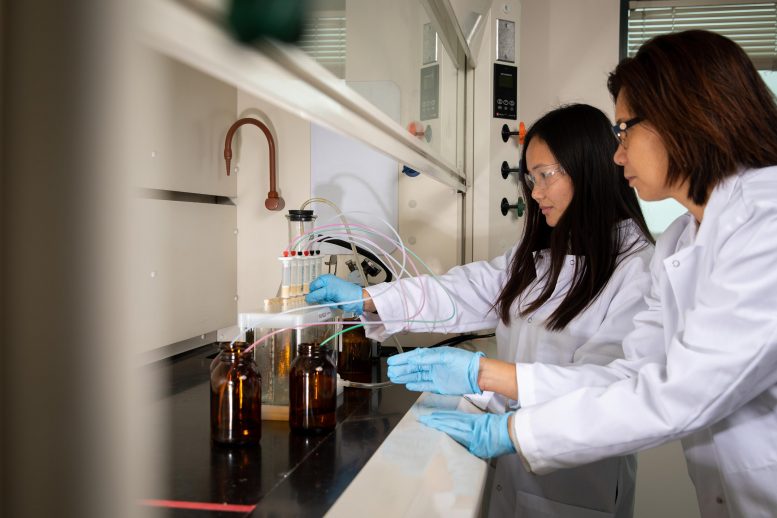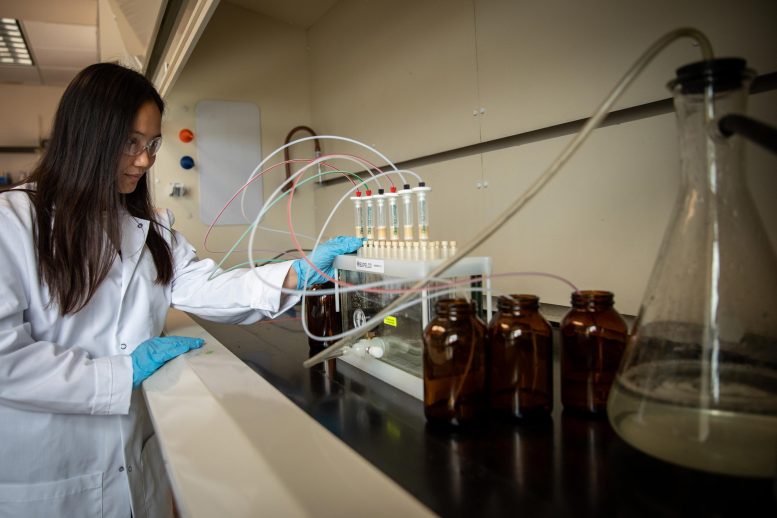Sewage Plants Can Remove Medicines From Wastewater – Here’s How
Published on by Water Network Research, Official research team of The Water Network in Academic
University at Buffalo chemistry professor Diana Aga (right) and UB chemistry PhD candidate Luisa Angeles in the lab. To study pharmaceuticals in wastewater, they use the system pictured to isolate chemical compounds from the wastewater. Credit: Meredith Forrest Kulwicki
New research shows that technologies are available, but the upgrades can be expensive.
A study of seven wastewater treatment plants in the Eastern United States reveals a mixed record when it comes to removing medicines such as antibiotics and antidepressants.
The research points to two treatment methods — granular activated carbon and ozonation — as being particularly promising. Each technique reduced the concentration of a number of pharmaceuticals, including certain antidepressants and antibiotics, in water by more than 95%, the scientists’ analysis found.
Activated sludge, a common treatment process that uses microorganisms to break down organic contaminants, serves an important purpose in wastewater treatment but was much less effective at destroying persistent drugs such as antidepressants and antibiotics.
“The take-home message here is that we could actually remove most of the pharmaceuticals we studied. That’s the good news. If you really want clean water, there are multiple ways to do it,” says Diana Aga, Ph.D., Henry M. Woodburn Professor of Chemistry in the University at Buffalo College of Arts and Sciences.
UB chemistry Ph.D. candidate Luisa Angeles in the lab. Credit: Meredith Forrest Kulwicki
“However, for plants that rely on activated sludge only, more advanced treatment like granular activated carbon and/or ozonation may be needed,” Aga adds. “Some cities are already doing this, but it can be expensive.”
The findings are important because any drugs discharged from treatment plants can enter the environment, where they may contribute to phenomena such as antibiotic resistance, or be consumed by wildlife.
“Our research adds to a growing body of work showing that advanced treatment methods, including ozonation and activated carbon, can be very effective at removing persistent pharmaceuticals from wastewater,” says Anne McElroy, PhD, Professor and Associate Dean for Research in the Stony Brook University School of Marine and Atmospheric Sciences.
BY SCIENCE DAILY
ORIGINAL ARTICLE-ROYAL SOCIETY OF CHEMISTRY
Assessing pharmaceutical removal and reduction in toxicity provided by advanced wastewater treatment systems
Luisa F. Angeles,  a Rachel A. Mullen,
a Rachel A. Mullen,  a Irvin J. Huang, d Christopher Wilson,
a Irvin J. Huang, d Christopher Wilson,  b Wendell Khunjar, c Howard I. Sirotkin, e Anne E. McElroy* d and Diana S. Aga
b Wendell Khunjar, c Howard I. Sirotkin, e Anne E. McElroy* d and Diana S. Aga  * a
* a
Abstract
Wastewater treatment plants (WWTPs) have been considered as hotspots for pharmaceutical residues, such as antidepressants, antimicrobials and active ingredients of over-the-counter drugs. Despite evidence of ecotoxicological effects of these microcontaminants on exposed fish in the aquatic systems, there is currently no regulation in terms of the levels of pharmaceutical residues allowable for release into the environment. Depending on the extent of treatment employed in WWTPs removal of pharmaceutical residues are highly variable. This study compares the removal efficiencies for several antimicrobials, antidepressants, and other pharmaceuticals at different stages of the wastewater treatment process of seven WWTPs that employ varying treatment technologies including biological, physical, advanced chemical oxidation, and a combination of two or more of these technologies. The concentrations of the pharmaceuticals were measured by liquid chromatography/mass spectrometry at multiple points during the course of treatment. Additionally, the ecotoxicological effects of the WWTP effluents were also evaluated based on the behavioral effects in larval zebrafish. It was found that biological treatment process provided negative to low removal (<50%), while activated carbon and ozonation provided high removal (>95% overall removal) for 14 out of 15, and 9 out of 11 compounds detected in WWTP influents, respectively. Notably, the final effluents of the seven WWTPs in this study did not show any significant behavioral alterations in zebrafish, indicating that despite differences in removal efficiencies all the treatment processes investigated are sufficient in preventing short-term biological effects.
Media
Taxonomy
- Pharmaceuticals Waste

